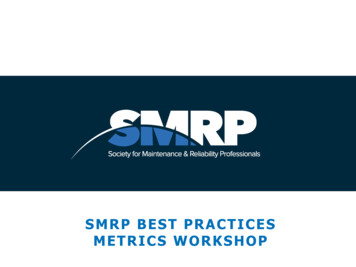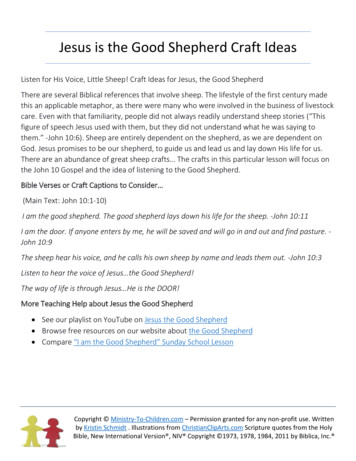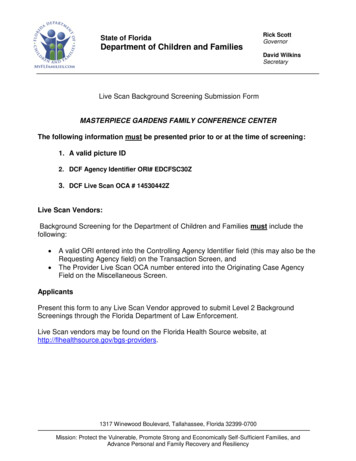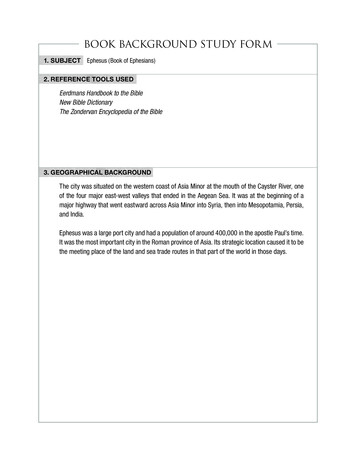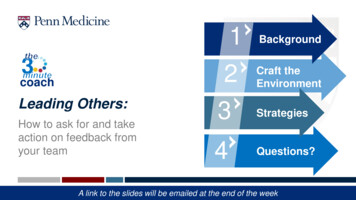
Transcription
13coachLeading Others:How to ask for and takeaction on feedback fromyour team234BackgroundCraft theEnvironmentStrategiesQuestions?A link to the slides will be emailed at the end of the week
Team benefits of upward feedbackEngagement Level: When Manager Asks and/or Gives Feedback80%60%40%20%74%29%35%Does not ask for feedbackDoes not give feedbackDoes not ask for feedbackGives feedback48%0%Asks for feedbackDoes not give feedbackAsks for feedbackGives feedback Employee engagement leads to greater productivity, innovation and retention Being asked for advice or feedback: Increases trust between employee and manager Signals to employees that it’s good to ask for feedbackUpward feedback leads to greater openness and honesty among teammates2
Leader benefits of upward feedback‣ Research has shown that: An environment where all team membersfeel empowered to give feedbackpositively impacts patient safety The most effective leaders ask morepeople for feedback and they ask forfeedback more often Those who continue to ask for feedbackthroughout their career end up being moretrusted.– Curious about your feedback preferences?Take this survey.“Managing Up” Can Improve Teamwork in the OR - Smith - 2010 - AORN Journal - Wiley Online Library3
Strategy: Set the stageCreating a culture where one feels safeto openly share and receive feedback begins with the managerExplain why you are askingEstablishing team normsI want to promote a more feedback rich environment within my team4
Strategy: Set the stageCreating a culture where one feels safeto openly share and receive feedback begins with the managerExplain why you are askingGive Time To Think About ItEstablishing team normsI want to promote a more feedback rich environment within my team5
Strategy: Set the stageCreating a culture where one feels safeto openly share and receive feedback begins with the managerExplain why you are askingGive Time To Think About ItReceive It LiveEstablishing team normsI want to promote a more feedback rich environment within my team6
Strategy: Set the stageCreating a culture where one feels safeto openly share and receive feedback begins with the managerExplain why you are askingGive Time To Think About ItReceive It LiveEstablishing team normsI want to promote a more feedback rich environment within my team7
Strategy: Create psychological safetyPromote Active ListeningEncourage employees to share more by thoughtfullyresponding and asking probing questionsPsychologicalSafetyThe degree to whichindividuals feelcomfortable takingpositive interpersonalrisks.Craft a Secure SettingModel being non-judgmental, actively encouragequestions, demonstrate inclusivity during meetingsDevelop an Open MindsetBeing open to new ideas encourages employees tochallenge the status quo and innovate.Lead by ExampleAsk for feedback, acknowledge mistakes, seek differentopinions and convey a positive attitudeBuilding Team Resilience(PDF) Psychological Safety, Trust, and Learning in Organizations: A Group-level Lens (researchgate.net)Psychological Safety: The History, Renaissance, and Future of an Interpersonal Construct, 2014 Amy C. Edmondson and Zhike Lei8
Strategy: Ask skillful questionsOpenEndedI’m always trying to improve as a professional and as a manager. Is there anything Icould be doing better or differently?TaskSpecificThe annual budget process is done! I’d love your take on anything we could dodifferently next year or ways I could change be more helpful to you and the team.Area-toWork-onI’m working on my attention to detail. Could you give me notes after this afternoon’spresentation when I didn’t get the details just right?PersonalimpactWhat did you take away from the team huddle?Feedbackas adviceI’m not sure how to get more feedback from the team Do you have any advice forme?When all else fails try “Tell me what you think I do not want to hear”9
Strategy: Model feedback-receptive behavior‣ When receiving feedback, give yourfull attention and listen carefully Eliminate distractions, including your phone andlaptop, and focus fully on the person giving thefeedback.Receiving Feedback10
Strategy: Model feedback-receptive behavior‣ When receiving feedback, give yourfull attention and listen carefully‣ Don’t debate or defend Notice your reactions, but do not offer contradictory evidence or challenge your colleague.If you debate, you will look defensive and you maydecrease the likelihood of that person offering youfeedback in the future.Receiving Feedback11
Strategy: Model feedback-receptive behavior‣ When receiving feedback, give yourfull attention and listen carefully‣ Don’t debate or defend‣ Manage your emotions Instead of finding fault in the messenger,become curious about yourself. Ask: Where isthis anger really coming from? What about thisis confusing? What part of the message isactually true for me, even if I don’t want toacknowledge it? If you find yourself getting emotional, explainyou need time to reflect and follow up with yourcolleague in the near future.Receiving Feedback12
Strategy: Model feedback-receptive behavior‣ When receiving feedback, give yourfull attention and listen carefully‣ Don’t debate or defend‣ Manage your emotions‣ Demonstrate gratitude Say thank you in a way that conveys sincereappreciation. Let them know how much you appreciatetheir effort and courage.Receiving Feedback13
Strategy: Learn from positive feedback Tells you what you don’t need to work on Can increase your motivation to improveX Is not the same as praise– Praise: “Nice job!”; “You were great in that meeting.”; “Killer presentation!”– Does not give us enough information to repeat the behavior.14
Strategy: Be open about what you are working on‣ Act on the feedback and discuss the impact of yourchanges Take all feedback into consideration Reflect on what you hear, make changes where appropriate Explain your thought process to ensure that youremployees feel heard‣ Sustain progress and share updates Update your feedback providers Tell them what you are doing differently. You’ll give them:– Validation that you heard and appreciated what they had to say– The opportunity to see you as a person who is committed toyour professional development.15
16Questions? Comments?Penn Medicine Resources‣ PennCOBALT a tool for the Penn ‣ Penn Medicine Academy:Community that uses targetedassessments to direct you to theright level of coping support.‣ Lead Strong Live discussions andcurated resources for PennMedicine employees aroundleading yourself and your teamduring adversity.‣ WELLfocused a programdedicated to making living ahealthy lifestyle easier, byproviding tools, resources,educational campaigns andhealth-related challenges to helpimprove overall well-being Microlearnings:– Creating a Feedback RichEnvironment Job Aids:– Giving Feedback– Soliciting Feedback– Receiving Feedback Classes: Tools and Resources forBuilding a Feedback RichEnvironment eLearning: Giving Feedbackwith the ADAPT Model Tools:ArticlesLinkedIn Learning‣ Team Learning and‣ Psychological Safety: ClearPsychological Safety Survey Measurement InstrumentDatabase for the SocialSciences (midss.org)‣ How Leaders Can Ask forthe Feedback No OneWants to Give Them(hbr.org)Road Blocks to Innovationand Collaboration‣ Self-awareness, Authenticityand Leadership‣ Becoming an Impactful andInfluential Leader (podcast)‣ Marshall Goldsmith: HowCan I Be Better? Inc.com‣ Top executives need‣ Lessons in EnlightenedLeadershipfeedback--here’s how theycan get it McKinsey Responsibility Matrix16
11 Strategy: Model feedback-receptive behavior ‣When receiving feedback, give your full attention and listen carefully Receiving Feedback ‣Don’t debate or defend Notice your reactions, but do not offer contradictory evidence or challenge your colleague. If you debate, you will look defensive and yo

